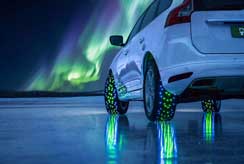
Self-driving cars will set requirements for tyres in the future. Sensors connected to tyres will be one of the things that play an important role when machines observe driving conditions instead of humans, says an expert from Nokian Tyres that believes smart tyres will be commonplace within five years at the latest.
The automatisation of traffic is advancing, which also sets new requirements for car tyres. When a car is not human-controlled, it must be able to individually observe driving conditions via sensors installed on tires, for example. The old and familiar safety characteristics, such as grip on ice and aquaplaning resistance, will be joined by technology that produces real-time data.
If a car does not have an active driver to ensure that the tyres are safe to use, safety needs to be measured in another way, says Mika Penttilä, Head of Digital Technology for Nokian Tyres.
When the information that is received from tyres is combined with weather data, for example, the vehicle’s on-board information system can form a picture of the prevailing driving conditions and adjust the driving accordingly. The tyre sensors can also monitor tire wear, inflation pressure, and the temperature inside the tyre. An increase in the inside temperature may be an early indication of tyre damage, for example, allowing it to be addressed before it causes a dangerous situation on the road.
No matter how smart your car is, tyres are the only link between the car and the road, says Jukka Kasi, Senior Vice President of Products & Marketing for Nokian Tyres.
The tyre will tell you when it needs to be replaced
Smart tyres also enable new tyre-related service models that can be utilised even before we ever see robotic cars on the streets.
– In the future, tyres will still continue to wear down and require replacement. However, purchasing a new tyre set may become more effortless and unnoticeable than before, Penttilä says.
Future refrigerators can order new milk when you are running out, and the same can happen with worn tyres. As tyres wear down, sensors can notify the tyre shop, which can then deliver a new set or even fit them on a vehicle. According to Jukka Kasi, however, the first step is to notify the driver of tyre wear.
“The tyre can relay the wear data to the onboard information system, which notifies the driver that the tyres can be safely used for another three months. At the same time, the system instructs them to contact the nearest tyre retailer and provides their contact information. This is similar to how current cars can notify the driver that they are running out of fuel and provide navigation guidance to the nearest service station.”
Preventive maintenance becomes especially important as the popularity of shared-use vehicles increases – and especially once they start operating autonomously. This ensures that the riders will not be stranded.
Smart tyres will appear before robotic cars
Even though the major revolution is still in the works, different sensor and smart tyre solutions are already available. TPMS tyre pressure sensors are already well-known to consumers, for example, but more advanced technology has so far been reserved for professional use. For instance, Nokian Tyres’s Intuitu is a concept for agriculture and contracting tyres that combines tyres with embedded sensors and a mobile app for data collection.
However, Jukka Kasi believes that solutions like Intuitu will become commonplace in consumer use – even before autonomous vehicles will be on the roads.
“Smart tyres will first become common on electric vehicles, since they have large tyres and lots of sensors and links to the tyres. This will happen in about five years,” Kasi summarises.
